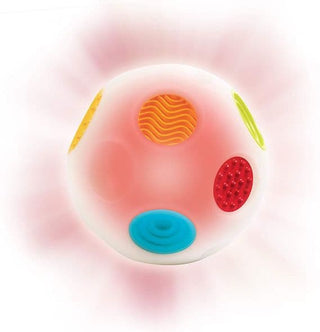What are Sensory Balls?
Sensory balls are also known as tactile or fidget balls and have gained popularity in recent years for their numerous therapeutic and recreational uses. They offer a wide range of benefits for individuals of all ages.
Sensory balls are tactile objects balls used to engage and stimulate the sense of touch. They come in various sizes, shapes, and textures, and they can be made from materials like rubber, silicone, foam, or fabric. Sensory balls are versatile tools that offer tactile and proprioceptive sensory input, making them suitable for children with additional needs and/or sensory processing difficulties.
What are the different types of sensory balls?
There is a wide variety of sensory balls available, each with its own unique characteristics and benefits.
Some common types of sensory balls include:
- Textured Balls: These balls have raised bumps, ridges, or spikes on their surface to provide sensory stimulation and tactile feedback.
- Stress Balls: These are soft, malleable stress balls that can be squeezed and moulded to help relieve stress and anxiety.
- Weighted Balls: These are filled with a weighted material, offering deep pressure and proprioceptive input, which can be calming and grounding.
- Gel-Filled Balls: Gel-filled sensory balls have a unique texture that can provide a soothing and squishy tactile experience.
- Light Up Balls: Some sensory balls are equipped with LED lights, adding a visual element to the sensory experience.
What are the benefits of Sensory Balls?
Sensory balls offer a wide range of benefits for individuals of all ages. Here are some of the key advantages associated with their use:
Sensory Stimulation
Sensory balls are excellent tools for providing sensory stimulation, especially for individuals with sensory processing difficulties. The various textures and tactile sensations they offer can help individuals become more aware of their bodies and sensory needs.
Stress Relief
Stress balls and gel-filled sensory balls are commonly used for stress relief. Squeezing and manipulating these balls can help reduce stress and anxiety by providing a physical outlet for tension.
Motor Skill Development
Sensory balls can promote the development of fine and gross motor skills in children. Activities like catching, throwing, and manipulating the balls can enhance hand-eye coordination and muscle strength.
Calming and Focus
Weighted sensory balls and those with textured surfaces can have a calming effect. They provide deep pressure input, which can help individuals with sensory regulation issues stay focused and reduce anxiety.
Therapeutic Uses
Sensory balls are frequently employed in occupational therapy and sensory integration therapy. They are used to address sensory processing disorders, autism, and other developmental challenges.
How can Sensory Balls be used with Children?
Sensory balls are versatile tools for children of all ages. Here's how they can be used with different age groups:
Infants and Toddlers
For infants and toddlers, soft and lightweight sensory balls are suitable. These can be used to encourage reaching, grasping, and rolling. Sensory balls with contrasting colors and gentle textures are especially engaging for young children.
School-Aged Children
School-aged children can benefit from a wider variety of sensory balls. Bouncy balls can be used for games and physical activity, while textured balls can be used to improve fine motor skills and sensory awareness. Sensory balls can also be used as a tool for self-regulation in the classroom.
Children with Special Needs
Children with sensory processing disorders, autism, or other special needs can greatly benefit from sensory balls. Weighted sensory balls and those with various textures can help these children self-soothe and regulate their sensory input.
Sensory Balls in Education
Sensory balls have found their way into educational settings as valuable tools for enhancing learning and focus. They can be used as classroom aids to help with attention issues or sensory sensitivities. Some teachers have integrated sensory balls into the classroom environment to create a more inclusive and engaging learning experience.
How to choose the right Sensory Ball?
Selecting the right sensory ball can be a matter of personal preference and intended use.
Consider factors like:
- What is the primary purpose of the sensory ball? Is it for stress relief, sensory stimulation, therapeutic use, or recreational play?
- Who will be using the sensory ball? Is it for a child, an adult, or someone with specific sensory needs?
- Do you have any specific preferences, such as texture or material, that are crucial for your sensory experience?
- Are you looking for a portable, travel-friendly option, or will it primarily be used in a specific environment?
Once you have a clear understanding of your goals, it's time to consider the essential factors when choosing a sensory ball.
- Texture - a critical factor when selecting a sensory ball. Some people prefer smooth surfaces, while others may benefit from textured or spiky options. Textured balls provide tactile stimulation and can be soothing or invigorating, depending on the texture.
- Size - sensory balls come in various sizes, from small, palm-sized options to larger balls. The size of the ball can impact how it fits in your hand and how it feels during use. Larger balls can provide more substantial input, while smaller ones may be more portable and suitable for smaller hands.
- Weight - can influence its therapeutic value. Weighted sensory balls, filled with materials like sand or beads, provide deep pressure input, which can be calming for some individuals. Lighter balls may be more suitable for activities that require tossing and catching.
- Durability - consider the durability of the sensory ball, especially if it will be used regularly or by children. Look for options made from high-quality materials that can withstand repeated use without deteriorating.
- Age and Skill Level - ensure that the sensory ball is age-appropriate and suitable for the intended user's skill level. Some sensory balls may be designed for infants, while others are better suited for older children or adults. Safety should always be a top priority.
Whether it's for relaxation, therapy, play, or sensory stimulation, the right sensory ball can be a valuable addition to your daily life, providing comfort and support in various ways.
Sensory balls are versatile tools that offer numerous benefits for individuals of all ages. Whether you're seeking stress relief, sensory stimulation, or a tool for therapeutic purposes, sensory balls have a place in various aspects of life. Their popularity in education and therapy continues to grow, highlighting their efficacy as tools for improving focus, motor skills, and sensory awareness. In summary, sensory balls are more than just fun toys; they are valuable tools for enhancing well-being and promoting sensory development.




